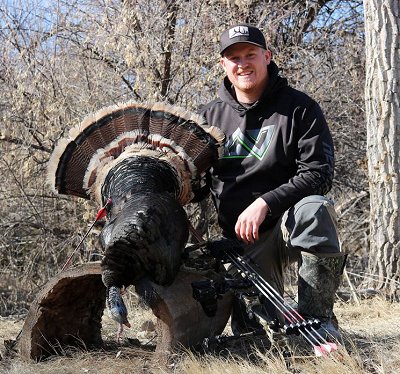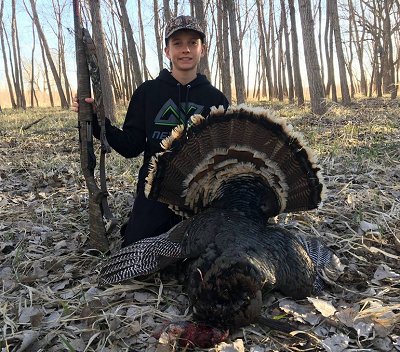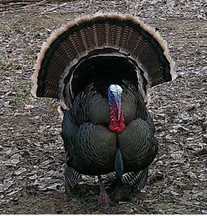Posted by Dan Carlson on Apr 14th 2020
Talkin' turkey with Nexgen Outfitters

Spring turkey season is here at last and there’s no better way to isolate during a pandemic because, for the most part, gobbler hunting is a solitary sport. Hunters venture into fields, woods and river bottoms clad head to toe in camo to search of an ambush site, and then spend a good deal of time seated in concealment while “talking” to wary toms.
Turkey hunting is popular for a number of reasons. Success rates are high once a turkey population is located. Older and physically challenged hunters are drawn to turkey hunting because it typically isn’t strenuous. It’s a great way to get new and young hunters into the sport and teach them about nature. And turkey hunting is more affordable than other kinds of hunting, requiring a tag, shotgun and camo clothing.
To find out more about hunting turkeys, I visited with Quinn Lund, one of the expert staff at Nexgen Outfitters in Sidney, Nebraska. Quinn is a veteran hunter and guide who really knows his stuff when it comes to pursuing game.
Quinn said the first step to getting a gobbler is to scout around and locate turkey populations. Because the birds can be seen in fields adjacent to woodlands in mornings and evenings, scouting can often be done at those times from a vehicle. All you need is binoculars and a tank of gas. Once you spot a flock of turkeys you’ll have to find out who owns the land (if it’s not open to public hunting) and get permission to hunt there.
If possible, visit the land you’ll be hunting on the evening before the hunt. Try to see where the turkeys head to roost in trees for the night. Then get there before sunrise, set up a decoy or two, and wait in your hiding spot for the turkeys to come down out of the trees around dawn.
Turkeys are wary creatures with excellent eyesight. That’s why good camouflage is important. Choose a pattern that blends well with the foliage in the area you’ll be hunting and remain as still as possible because turkeys can pick up on even the slightest movements. Nexgen Outfitters has a wide range of camo and help is available if you need advice on which pattern to choose.
A typical decoy setup might include a few hens, a Jake and maybe a gobbler. You can get as simple or fancy as you like with your decoys. Many are collapsible and easy to carry to and from your hunting spot. Nexgen Outfitters has a good selection of turkey decoys to choose from. You’ll want to set them out at a distance from your hiding spot at a range you’re comfortable shooting game. Quinn says turkeys will come right in to your decoys so if you’re most comfortable shooting at 20 yards, set the decoys 20 yards from your ambush spot.
You may arrive to hunt and not see any turkeys. They can be highly mobile and often aren’t too far away from where they roosted. To find them, Quinn suggests using a locator call. These calls are made to draw a response from tom turkeys nearby. Quinn says owl locator calls work best first thing in the morning or late in the evening. Crow calls work best during the middle of the day. When used correctly, locator calls will trigger an angry vocal response from gobblers within earshot, letting you know where they are.
Once turkeys are located and your decoys are set up, it’s time to “talk” to turkeys in the area with a turkey call. Nexgen Outfitters has dozens of turkey calls to choose from. There are diaphragm calls that you insert into your mouth, slate pot calls that make various turkey sounds as you scratch a surface, box calls made of wood and shaker calls you shake with your hand. Be cautious with shaker calls as they require movement a wary tom might pick up. Most turkey calls are easy to use once you get the hang of it but you’ll need to practice a bit before using one on a hunt.
Any shotgun or bow you use to hunt other game can be used to hunt turkeys. The same goes for shotgun ammo and arrows. But some hunters like to use shotgun loads specifically developed for taking turkeys. This is typically high-velocity ammo in 3" or 3.5" shells with No. 4 or No. 5 shot. While a modified choke can be used on turkeys at close range, most turkey hunters use a full choke or special turkey choke to produce hard-hitting narrow shot patterns out to 40 yards or more. Such chokes keep the shot pattern together over a farther distance and improve the chances of a quick, humane kill-shot striking the turkey’s head or neck at longer ranges.
You’ll need something to keep your shells, binoculars, lunch and other gear in as you go to and from your hunting spot. Quinn suggests the Whitetail Caddy , a rugged camo hunting pack designed by and made exclusively for the team at Nexgen Outfitters. Don’t let the name fool you. The Whitetail Caddy is great for any hunting application and is loaded with features serious hunters want in a daypack.
If you’re confident you’ll be staying at or near one place during your hunt, Quinn suggests you consider a hunting blind . Blinds often deliver a more comfortable and forgiving hunting option to sitting still under a tree. You can set up your favorite hunting chair inside a blind and spread your gear out around you as you like. Blinds also offer a measure of protection from rain and wind in addition to letting you move around a bit if you get stiff. Blinds are perfect for hunting with kids too. They conceal the movement of young hunters and make the experience seem more like a combined hunting and camping adventure.
These are just a few ideas and suggestions as you prepare to harvest turkeys this spring. If you have any questions, just visit https://nexgenof.com and call Nexgen Outfitters or use the online chat feature to interact with one of the experts on our team.


